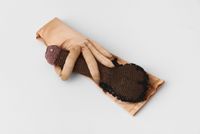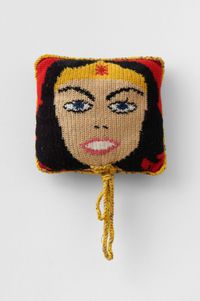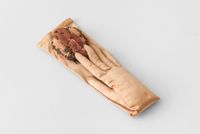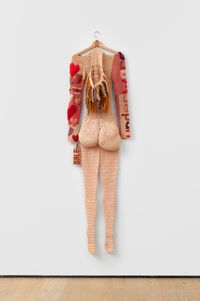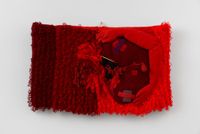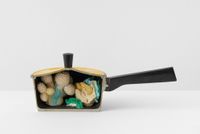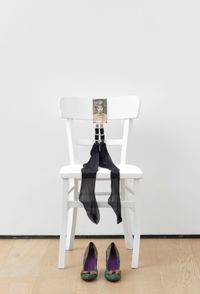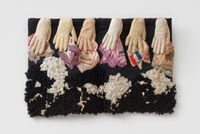A forerunner of British Feminist Art, Su Richardson creates humorous and subversive crocheted sculptures that confront notions of femininity and domesticity.
Read MoreSince the 1970s Su Richardson has been living and working in Birmingham, where she met artists Monica Ross and Phil Goodall. The trio formed the Birmingham Women's Art Group. Among the collective's most acclaimed works is Feministo (1975–1977): an art event in which women exchanged ideas and artworks through the post. Many of the participants were young mothers restricted by their role; the project offered them an opportunity to consider the home as a space of artistic productivity.
One of the first works Su Richardson sent for Feministo was a crocheted work depicting the single word 'ME', inviting self-reflection and reinforcing the project's ethos of, as the artist told Studio International in 2018, 'reclaiming yourself'. From Feministo also emerged Richardson's iconic Burnt Breakfast (1975), consisting of crocheted breakfast foods on crocheted plates—an inviting meal charred in places upon closer inspection.
Feministo developed into the exhibition Portrait of the Artist as Housewife (1977) at London's Institute of Contemporary Arts. Presenting domestic scenes featuring crocheted and embroidered works, the exhibition challenged notions of craft—traditionally 'women's work'. In her 2018 interview with Studio International, Richardson reflected that she deliberately made her works 'humorous, colourful, nice to look at so people would come and look at it before anything else'.
Su Richardson's works frequently and emphatically critique patriarchal definitions of femininity. Underwear Skin Sale (1978)—a life-sized crocheted female form—comes with a price tag, referring to the sexual objectification rife in pageants such as the Miss World Contest, while strings hang ominously from the crocheted Wonderwoman Strangling Herself with her own Lanyard (1983).
Su Richardson also was part of the collaborative project Fenix (1977–1978) with Kate Walker, Monica Ross, and Suzy Varty. For Fenix, galleries hosted the artists for a week each in lieu of permanent studio space. During each micro-residency the artists would build an installation. Early Feminist art champion Lucy Lippard curated Fenix into her exhibition Issue: Social Strategies at the Institute of Contemporary Arts in London (1980).
Around the mid-1980s, Su Richardson moved away from the art world and joined the British pop band Terry and Gerry. Her more recent works continue to engage with feminist discourses. Expressing Breasts (Blood, Tears, Milk, Bad Blood) (2017), for example, explores motherhood and the invariable eroticisation of the female body, presenting four crocheted breasts on the wall, each appearing to drip an unknown liquid from the nipple.
Wonderwoman, Richard Saltoun Gallery (2020); Burnt Breakfast and other works, Constance Howard Gallery, London (2012).
This Life is so Everyday: The Home in British Art 1950–1980, Graves Gallery, Sheffield, United Kingdom (2019); Women Power Protest, Birmingham Museum and Art Gallery (2018); Home Strike, l'étrangère, London (2018); Birmingham Show, Eastside Projects, United Kingdom (2015); Women and Textiles, Battersea Arts Centre, London (1983).
Sherry Paik | Ocula | 2020
